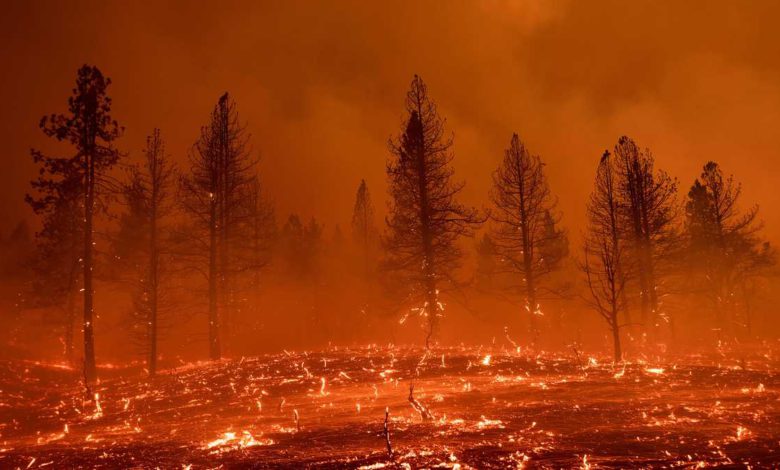

Video above: California fires advance as heat wave covers WestThe National Interagency Fire Center says 55 large fires have burned over 768,000 acres across 12 states.The acreage — about 1,200 square miles — is comparable to four times the area of New York City.From Jan. 1 to July 11 this year, over 1.8 million acres have burned in 33,491 fires, according to the NIFC, surpassing the previous year's tally for the same period.The number of fires burned so far this year is the second-highest to 2011's 39,459 fires.Fires in the Golden State have charred thousands of acres, more than doubling the amount burned for the same time frame last year.At least 73,511 acres have burned in 4,599 fires from Jan. 1 through July 4, Cal Fire said last week. Comparatively, 31,111 acres burned in 3,847 fires in 2020."While wildfires are a natural part of California's landscape, the fire season in California and across the West is starting earlier and ending later each year," according to Cal Fire's website."Climate change is considered a key driver of this trend. Warmer spring and summer temperatures, reduced snowpack, and earlier spring snowmelt create longer and more intense dry seasons that increase moisture stress on vegetation and make forests more susceptible to severe wildfire. The length of the fire season is estimated to have increased 75 days across the Sierras and seems to correspond with an increase in the extent of forest fires across the state."Below is a roundup of some key fires:CaliforniaBeckwourth Complex Fire: 86,076 acres, 20% containedThe Complex comprises the Dotta Fire and Sugar Fire burning in the Plumas National Forest.The Dotta Fire started June 30 on the Beckwourth Ranger District near Dotta Canyon.The Sugar Fire started July 2 on the Beckwourth Ranger District west of Sugarloaf Peak.Both fires were ignited by lightning.This is the largest fire burning in the state, and it is not clear how many structures or homes have burned, if any.Evacuations impacted 3,061 people and 1,199 residences are threatened according to fire information spokesperson Mike Ferris. A total of 2,326 personnel are battling the fire complex.River Fire: 4,000 acres, 5% containedThe River Fire is burning near Yosemite National Park west of Highway 41 in Mariposa and Madera counties. The fire started July 11.Mandatory evacuations are in place in parts of both counties and at least 251 firefighters are battling the blaze."Firefighting efforts have been hampered due to hot, dry, and windy conditions. The fire is burning in oak/grass woodland," according to Cal Fire.More California fires on the radarJuniper Fire: 1,011 acres, 70% contained in the Modoc National Forest. Started July 5.Lava Fire: 25,409 acres, 75% contained, Shasta-Trinity National Forest. Started by lightning near Weed, California, on June 24.Salt Fire: 12,650 acres, 70% contained; Shasta-Trinity National Forest. No growth over the weekend. Started June 30.Tennant Fire: 10,580 acres, 95% contained; Klamath National Forest. Started June 28.Willow Fire: 2,877 acres, 95% contained; Los Padres National Forest. Started June 17. ArizonaCedar Basin Fire: 714 acres, 0% containedThe fire was started July 9, by lightning about 14 miles northeast of Wikieup, Arizona, and 20 miles northwest of Bagdad, Arizona.New MexicoJohnson Fire: 88,918 acres, 75% containedThe Johnson Fire started May 20 and was caused by lightning, according to incident reports from the Gia National Forest. OregonBootleg Fire: 150,812 acres, 0% containedThe fire started July 6 on the Fremont-Winema National Forest in Klamath County.The cause is still under investigation.Officials estimate full containment of the fire near the California border by Nov. 30.Hot, dry, windy weather is hampering firefighting efforts, creating life-threatening risks to area residents, according to an incident update.The fire prompted a flex alert from California ISO for Monday. A flex alert is a request for users to conserve electricity when there is an anticipated shortage of energy supply.
Video above: California fires advance as heat wave covers West
The National Interagency Fire Center says 55 large fires have burned over 768,000 acres across 12 states.
The acreage — about 1,200 square miles — is comparable to four times the area of New York City.
From Jan. 1 to July 11 this year, over 1.8 million acres have burned in 33,491 fires, according to the NIFC, surpassing the previous year's tally for the same period.
The number of fires burned so far this year is the second-highest to 2011's 39,459 fires.
Fires in the Golden State have charred thousands of acres, more than doubling the amount burned for the same time frame last year.
At least 73,511 acres have burned in 4,599 fires from Jan. 1 through July 4, Cal Fire said last week. Comparatively, 31,111 acres burned in 3,847 fires in 2020.
"While wildfires are a natural part of California's landscape, the fire season in California and across the West is starting earlier and ending later each year," according to Cal Fire's website.
"Climate change is considered a key driver of this trend. Warmer spring and summer temperatures, reduced snowpack, and earlier spring snowmelt create longer and more intense dry seasons that increase moisture stress on vegetation and make forests more susceptible to severe wildfire. The length of the fire season is estimated to have increased 75 days across the Sierras and seems to correspond with an increase in the extent of forest fires across the state."
Below is a roundup of some key fires:
California
Beckwourth Complex Fire: 86,076 acres, 20% contained
The Complex comprises the Dotta Fire and Sugar Fire burning in the Plumas National Forest.
The Dotta Fire started June 30 on the Beckwourth Ranger District near Dotta Canyon.
The Sugar Fire started July 2 on the Beckwourth Ranger District west of Sugarloaf Peak.
Both fires were ignited by lightning.
This is the largest fire burning in the state, and it is not clear how many structures or homes have burned, if any.
Evacuations impacted 3,061 people and 1,199 residences are threatened according to fire information spokesperson Mike Ferris. A total of 2,326 personnel are battling the fire complex.
River Fire: 4,000 acres, 5% contained
The River Fire is burning near Yosemite National Park west of Highway 41 in Mariposa and Madera counties. The fire started July 11.
Mandatory evacuations are in place in parts of both counties and at least 251 firefighters are battling the blaze.
"Firefighting efforts have been hampered due to hot, dry, and windy conditions. The fire is burning in oak/grass woodland," according to Cal Fire.
More California fires on the radar
Juniper Fire: 1,011 acres, 70% contained in the Modoc National Forest. Started July 5.
Lava Fire: 25,409 acres, 75% contained, Shasta-Trinity National Forest. Started by lightning near Weed, California, on June 24.
Salt Fire: 12,650 acres, 70% contained; Shasta-Trinity National Forest. No growth over the weekend. Started June 30.
Tennant Fire: 10,580 acres, 95% contained; Klamath National Forest. Started June 28.
Willow Fire: 2,877 acres, 95% contained; Los Padres National Forest. Started June 17.
Arizona
Cedar Basin Fire: 714 acres, 0% contained
The fire was started July 9, by lightning about 14 miles northeast of Wikieup, Arizona, and 20 miles northwest of Bagdad, Arizona.
New Mexico
Johnson Fire: 88,918 acres, 75% contained
The Johnson Fire started May 20 and was caused by lightning, according to incident reports from the Gia National Forest.
Oregon
Bootleg Fire: 150,812 acres, 0% contained
The fire started July 6 on the Fremont-Winema National Forest in Klamath County.
The cause is still under investigation.
Officials estimate full containment of the fire near the California border by Nov. 30.
Hot, dry, windy weather is hampering firefighting efforts, creating life-threatening risks to area residents, according to an incident update.
The fire prompted a flex alert from California ISO for Monday. A flex alert is a request for users to conserve electricity when there is an anticipated shortage of energy supply.
Source link









